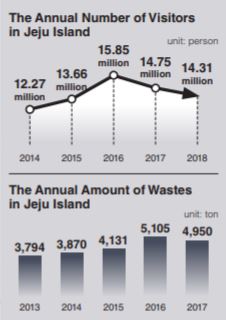After exhausting final exams, the summer vacation is coming. Perhaps, many Kingos are planning to go on a trip during the vacation. Thinking back, Kingos may have wanted to actually live in the tour destination with the beautiful scenery, food, and atmosphere. The real lives of local residents, however, are quite different from fantasies. The SungKyun Times (SKT) now looks into tourism phobia, which refers to a dislike or fear of tourists among residents, analyzes the causes of the phenomenon and finds out possible solutions.
What Is Tourism Phobia?

Tourism phobia is a new word which combines the words “tourism” and “phobia”, and represents residents’ antitourism sentiments. The phenomenon usually occurs in places where tour resources and residential spaces are not completely divided. Residents whose livelihoods are under threat even distribute leaflets or demonstrate against tourists coming in. For example, in Korea, the Bukchon Hanok Village is a famous tourist spot where an average of ten thousand people visits every day. Since a large number of visitors make noise and throw garbage at the village, residents have hung banners on the walls that say “Residents Want to Live Like Human Beings.” Experts say that the increase in tourists and unbalanced distribution of tourist attractions are the main reasons for tourism phobia. Although the number of residents of Venice in Italy is only 50 thousand, the annual number of tourists is about 25 million. In 2017, about 2,000 Venetian residents demonstrated against the excessive tourism in San Marco Square. In Korea, local governments are obsessed with attracting tourists. Although developing tourism is beneficial because it generates tangible and intangible economic effects such as increasing resident income and revitalizing local markets, excessive policies that do not fit in with the local situation have side effects. Nangman Pocha is one of the most popular tourist attractions in Yeosu, because of its beautiful scenery, delicious seafood, and drinks. Due to the residents’ protest about noise and garbage problems, however, relocation of the Pocha will be conducted this upcoming September.
Pain of Residents in Tourist Spots
Environmental Pollution and Inconvenience of Local Residents

Sadly, a large number of tourists leads to a large amount of trash, which makes the residents who live there dispose of more trash. The number of tourists to Jeju Island reaches about 15 million a year. Jeju’s garbage incinerator can handle 140 tons a day, but the amount of trash it has to handle in a day is over 210 tons. Therefore, 70 tons of garbage is piled up every day, and now, 50,000 tons of compressed waste is piled up and form a garbage mountain in Jeju. Some tourists often sing loudly or trespass on residents’ property. Therefore, residents attach signs such as “Silence Please”, or “Don’t Step” on the wall. Tourists even throw their trash on the street. In addition, due to a large number of tourists, parking spaces become scarce and roads become crowded.
A Rise in Real Estate Prices
As accommodation sharing services such as Airbnb have developed in tourist spots, investors buy residential houses and replace them with more profitable accommodations for tourists. Therefore, the supply of residential houses is reduced, and the rental price rises. Residents are forced out of their homes because of the rise in the rental price, and tourists take over the place. After Germany found that Airbnb is a part of the cause of the high rental price, Germany tightened restrictions on Airbnb. As a result, many rental apartments became available in the housing market. Furthermore, life essential facilities such as laundrettes, grocery stores, and bathhouses disappear because of the rise in rent. Instead, restaurants, bars, souvenir shops, and other tourist attractions are opened, and residents often have conflicts with owners of such new businesses.
Attempts to Solve the Problems
Imposition of Tourism Tax
Tourism taxes can cover the costs of urban environment protection, safety maintenance and improvement of residents’ life quality. This tax can be included in the cost of accommodation or airfares. The New Zealand government is considering imposing 25 to 35 dollars of tourism tax on foreign tourists, except for people from Pacific Island countries, due to the environmental pollution caused by tourists and the worsening living conditions of residents. New Zealand’s Minister of Tourism said the government’s income from the tourism tax can be used to expand infrastructure and protect the environment for the residents living in tourist spots.
Dispersing Tourists
According to the policy to disperse tourists, tourist destinations provide visitors with guidance and recommendations about other tourist attractions around them and offer real-time information about famous tourist sites that helps to avoid congested time zones. Amsterdam in the Netherlands informs tourists on real-time congestion of major tourist attractions in the city via smartphone and provides information on various tourist attractions.
Fair-tourism

Fair tourism comes from the concept of fair trade. It emphasizes the ethical responsibilities of tourists so that the profits of tourism go back to local residents, which means the virtuous cycle of mature tourism culture and tourism profits that are used for residents and villages. Gamcheon Culture Village in Busan can be a good example. The village formed a community council and generates profits from tourists. About 30 jobs that only hire residents of the village were created and the community uses 200 million won of the tourism profits for the welfare of residents every year. Also, the tour route is marked with a yellow path, separating the residents’ living spaces from the wandering tourists. This shows that a win-win relationship between residents and tourists is possible.
The government should not sacrifice locals for the development of the tourism industry. Appropriate policies are important in order to eliminate tourism phobia, but the establishment of a mature tourism culture is also important. The SKT hopes that Kingos will be tourists who respect the lives of local residents.
